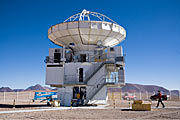Nota de Imprensa
Sub-millimetre Astronomy in Full Swing on Southern Skies
Impressive set of APEX Results to be published in Special Issue of Astronomy & Astrophysics
13 de Julho de 2006
The Atacama Pathfinder Experiment (APEX) 12-m sub-millimetre telescope lives up to the ambitions of the scientists by providing access to the "Cold Universe" with unprecedented sensitivity and image quality. As a demonstration, no less than 26 articles based on early science with APEX are published this week in the research journal Astronomy & Astrophysics. Among the many new findings, most in the field of star formation and astrochemistry, are the discovery of a new interstellar molecule, and the detection of light emitted at 0.2 mm from CO molecules, as well as light coming from a charged molecule composed of two forms of Hydrogen.
Using both APEX and the IRAM 30-metre telescope the first astronomical detection of a charged molecule composed of Carbon and Fluorine - the 'CF+ ion' - was made. Prior to this discovery, only one fluorine-containing molecular species had been found in space so far, the HF molecule ('hydrogen fluoride'), consisting of one atom of Hydrogen and one of Fluorine. The newly discovered molecule, produced through a reaction between Carbon and the HF molecule, was found in a region adjoining the Orion Nebula, one of the nearest and most active stellar nurseries in the Milky Way. This detection provides support to the astronomers' understanding of interstellar fluorine chemistry, suggesting that hydrogen fluoride is ubiquitous in interstellar gas clouds.
Another premiere is the detection - also in the Orion star-forming region - of light emitted by carbon monoxide (CO) at a wavelength of 0.2 mm. These short wavelengths are very difficult to investigate, both because the water vapour in the atmosphere attenuates the signal even more severely than elsewhere in the submillimeter range, but also because they are at the limit of the telescope's operating range. The detection of CO at these wavelengths, the very shortest accessible from Earth in any of the submillimeter 'windows', proves the superb efficiency of APEX.
Light coming from a charged molecule composed of Hydrogen and Deuterium (H2D+) was detected in several cold clouds in the Southern Sky. The H2D+ ion is interesting because it traces gas so cold (a few degrees above the absolute zero!) that only a few molecular species have not frozen out onto the surfaces of dust grains.
These are not the only significant discoveries made. Other highlights include the first observations of atomic carbon in the so-called "Pillars of Creation" in the Eagle Nebula (also known as Messier 16), a sub-millimetre study of a massive hot core, of a high-mass star forming region, as well as of a high velocity outflow coming from a young stellar object. Studies of molecular regions in the dwarf galaxy NGC 6822 and in the starburst galaxy NGC 253 were also done, proving that APEX can also contribute to the exploration of extragalactic objects.
Apart from the astronomical studies, a series of contributions deal with the technical aspects of APEX, such as the telescope itself, its software, its receivers and spectrometers. The latter were developed at the Max-Planck-Institut für Radioastronomie in Bonn, Germany and at the Swedish Chalmers University, while the 0.2 mm receiver was developed at the University of Cologne (Germany).
The APEX telescope, designed to work at sub-millimetre wavelengths, in the 0.2 to 1.5 mm range, passed successfully its Science Verification phase in July 2005 (see eso0522 and eso0531), and since then is performing regular science observations. It is located on the 5100 m high Chajnantor plateau in the Atacama Desert (Chile), probably the driest place on Earth. It is a collaborative effort between the Max-Planck-Institut für Radioastronomie, ESO and the Onsala Space Observatory (Sweden).
With its precise antenna and large collecting area, APEX provides, at this exceptional location, unprecedented access to a whole new domain in astronomical observations. Indeed, millimetre and sub-millimetre astronomy opens exciting new possibilities in the study of the first galaxies to have formed in the Universe and of the formation processes of stars and planets. It also allows astronomers to study the chemistry and physical conditions of molecular clouds, that are dense regions of gas and dust in which new stars are forming.
APEX is the pathfinder to the ALMA project. In fact, it is a modified ALMA prototype antenna and is located at the future site of the ALMA observatory. ALMA will consist of a giant array of 12-m antennas separated by baselines of up to 14 km and is expected to gradually start operation by the end of the decade.
The Astronomy & Astrophysics special issue (volume 454 no.2 - August I, 2006) on APEX first results includes 26 articles. They are freely available in PDF format from the publisher website.
These results are partly based on APEX science verification data that are available from the ESO archive at http://www.eso.org/science/apexsv/.
More information on APEX is available at http://www.apex-telescope.org/.
Contactos
Carlos De Breuck
ESO
Garching, Germany
Tel: +49 89 3200 6613
Email: cdebreuc@eso.org
Karl Menten
Max-Planck-Institut für Radioastronomie
Garching, Germany
Tel: +49 228-52 52 97
Email: kmenten@mpifr-bonn.mpg.de
Sobre a Nota de Imprensa
| Nº da Notícia: | eso0624 |
| Legacy ID: | PR 24/06 |
| Nome: | Atacama Pathfinder Experiment |
| Tipo: | Unspecified : Technology : Observatory : Telescope |
| Facility: | Atacama Pathfinder Experiment |
Our use of Cookies
We use cookies that are essential for accessing our websites and using our services. We also use cookies to analyse, measure and improve our websites’ performance, to enable content sharing via social media and to display media content hosted on third-party platforms.
ESO Cookies Policy
The European Organisation for Astronomical Research in the Southern Hemisphere (ESO) is the pre-eminent intergovernmental science and technology organisation in astronomy. It carries out an ambitious programme focused on the design, construction and operation of powerful ground-based observing facilities for astronomy.
This Cookies Policy is intended to provide clarity by outlining the cookies used on the ESO public websites, their functions, the options you have for controlling them, and the ways you can contact us for additional details.
What are cookies?
Cookies are small pieces of data stored on your device by websites you visit. They serve various purposes, such as remembering login credentials and preferences and enhance your browsing experience.
Categories of cookies we use
Essential cookies (always active): These cookies are strictly necessary for the proper functioning of our website. Without these cookies, the website cannot operate correctly, and certain services, such as logging in or accessing secure areas, may not be available; because they are essential for the website’s operation, they cannot be disabled.
Functional Cookies: These cookies enhance your browsing experience by enabling additional features and personalization, such as remembering your preferences and settings. While not strictly necessary for the website to function, they improve usability and convenience; these cookies are only placed if you provide your consent.
Analytics cookies: These cookies collect information about how visitors interact with our website, such as which pages are visited most often and how users navigate the site. This data helps us improve website performance, optimize content, and enhance the user experience; these cookies are only placed if you provide your consent. We use the following analytics cookies.
Matomo Cookies:
This website uses Matomo (formerly Piwik), an open source software which enables the statistical analysis of website visits. Matomo uses cookies (text files) which are saved on your computer and which allow us to analyze how you use our website. The website user information generated by the cookies will only be saved on the servers of our IT Department. We use this information to analyze www.eso.org visits and to prepare reports on website activities. These data will not be disclosed to third parties.
On behalf of ESO, Matomo will use this information for the purpose of evaluating your use of the website, compiling reports on website activity and providing other services relating to website activity and internet usage.
Matomo cookies settings:
Additional Third-party cookies on ESO websites: some of our pages display content from external providers, e.g. YouTube.
Such third-party services are outside of ESO control and may, at any time, change their terms of service, use of cookies, etc.
YouTube: Some videos on the ESO website are embedded from ESO’s official YouTube channel. We have enabled YouTube’s privacy-enhanced mode, meaning that no cookies are set unless the user actively clicks on the video to play it. Additionally, in this mode, YouTube does not store any personally identifiable cookie data for embedded video playbacks. For more details, please refer to YouTube’s embedding videos information page.
Cookies can also be classified based on the following elements.
Regarding the domain, there are:
- First-party cookies, set by the website you are currently visiting. They are stored by the same domain that you are browsing and are used to enhance your experience on that site;
- Third-party cookies, set by a domain other than the one you are currently visiting.
As for their duration, cookies can be:
- Browser-session cookies, which are deleted when the user closes the browser;
- Stored cookies, which stay on the user's device for a predetermined period of time.
How to manage cookies
Cookie settings: You can modify your cookie choices for the ESO webpages at any time by clicking on the link Cookie settings at the bottom of any page.
In your browser: If you wish to delete cookies or instruct your browser to delete or block cookies by default, please visit the help pages of your browser:
Please be aware that if you delete or decline cookies, certain functionalities of our website may be not be available and your browsing experience may be affected.
You can set most browsers to prevent any cookies being placed on your device, but you may then have to manually adjust some preferences every time you visit a site/page. And some services and functionalities may not work properly at all (e.g. profile logging-in, shop check out).
Updates to the ESO Cookies Policy
The ESO Cookies Policy may be subject to future updates, which will be made available on this page.
Additional information
For any queries related to cookies, please contact: pdprATesoDOTorg.
As ESO public webpages are managed by our Department of Communication, your questions will be dealt with the support of the said Department.


